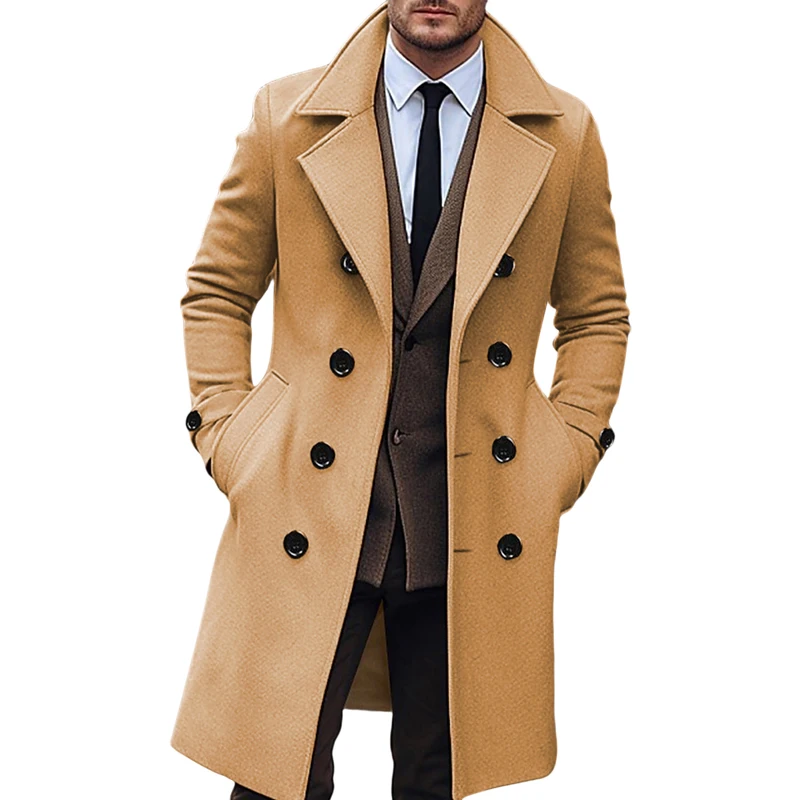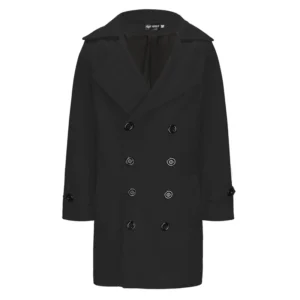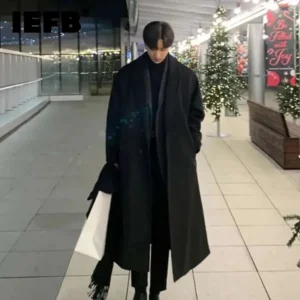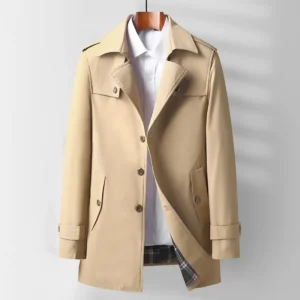The Evolution and Appeal of the Double-Breasted Coat
The double-breasted coat enjoys a rich heritage that stretches back to naval uniforms of the 18th and 19th centuries. Originally designed for naval officers who needed protection against harsh sea conditions, this distinctive garment featured overlapping front panels with two parallel rows of buttons—a practical design that provided extra warmth and protection against wind and water.
As civilian fashion adopted military styling, the double-breasted coat made its transition from shipdecks to city streets, becoming a symbol of authority, confidence, and refined taste. The coat’s distinctive silhouette, characterized by its broad shoulders, nipped waist, and overlapping front closure, creates a powerful V-shaped torso that many men find flattering.
What makes this classic piece endure while other styles come and go is its perfect balance of boldness and sophistication. Unlike its single-breasted cousin, which prioritizes subtlety, the double-breasted coat makes a statement. Its distinctive appearance projects confidence without appearing flashy—a rare quality in menswear.
Throughout history, style icons from the Duke of Windsor to modern celebrities have embraced the ultimate guide to men’s double-breasted coats as a signature piece, cementing its status as a timeless garment that transcends fashion trends. The double-breasted coat isn’t just clothing; it’s a style statement with substance and history.
Essential Elements of a Quality Double-Breasted Coat
Understanding the key components of a quality double-breasted coat allows you to make better purchasing decisions and appreciate the craftsmanship that goes into these garments.
Lapels: The most distinctive feature of a double-breasted coat is typically its peak lapels. These upward-pointing lapels create a strong shoulder line and accentuate the chest. While notch lapels occasionally appear on double-breasted coats, peak lapels remain the classic choice for their ability to enhance the coat’s powerful silhouette.
Button Configuration: Double-breasted coats are described by their button arrangement, expressed as “6×2” or “4×2” — the first number represents the total buttons, while the second indicates how many actually fasten. The 6×2 arrangement (six buttons with two functional) is the most traditional and formal, while 4×2 offers a more contemporary look.
Proper Proportions: Quality double-breasted coats maintain balanced proportions between shoulders, waist, and length. The shoulders should be structured but not excessively wide, and the waist should taper slightly to create that distinctive V-shaped silhouette.
Materials Matter: Premium wool with weights between 18-24 ounces provides the best combination of warmth, durability, and drape. Cashmere blends offer luxurious softness but require more careful maintenance. The advantages of double-breasted coats include superior insulation due to the overlapping front panels.
Construction Details: Look for hand-stitched elements, particularly around the collar and armholes, which indicate quality craftsmanship. Fully canvassed construction (rather than fused) ensures the coat will conform to your body over time and maintain its shape for years.
For those ready to invest in a quality piece, exploring men’s double-breasted overcoat options will reveal how these elements come together in expertly crafted garments that balance form and function.
Finding Your Perfect Fit: The Foundation of Style
The most exquisite double-breasted coat in the world will fail to impress if it doesn’t fit properly. Unlike more forgiving single-breasted styles, the double-breasted coat demands precision in fit to achieve its intended effect.
Shoulders: The coat’s shoulder seams should align with your natural shoulders. Too narrow, and you’ll experience restriction of movement; too wide, and you’ll appear sloppy. When trying on a coat, the shoulder should hug the natural curve of your shoulder without extending beyond it or pinching inward.
Chest: With all buttons fastened, you should have enough room to comfortably fit a fist between your chest and the coat. The lapels should lie flat against your chest without gapping or pulling.
Sleeve Length: Proper sleeve length should allow approximately ¼ to ½ inch of your shirt cuff to show when your arms are at your sides. This subtle detail makes a significant difference in the overall appearance.
Coat Length: A classic double-breasted overcoat should end somewhere between mid-thigh and just above the knee. This length provides both functionality and proportion.
Common Fit Mistakes: Avoid the temptation to size up for a more relaxed fit—this undermines the structured elegance that defines the double-breasted style. Similarly, avoid excessively tight fitting that causes the buttons to pull or the back to stretch when moving.
For those with broader builds, a slightly lower button stance can create a more flattering silhouette, while slimmer individuals might benefit from a slightly higher button placement to create balance.
The expert guide to double-breasted coat fit provides tailored advice for different body types, ensuring your investment piece enhances rather than hinders your appearance.
Classic Business and Formal Combinations
The double-breasted coat reaches its full potential when paired with formal and business attire, creating a powerful impression of authority and refinement.
For traditional business settings, layer your navy or charcoal double-breasted coat over a gray or navy suit. The coat’s structure complements tailored suiting perfectly, creating a cohesive silhouette. Choose a crisp white shirt with a semi-spread collar that accommodates the wider lapels of your coat. A silk tie in burgundy, navy, or subtle patterns adds color while maintaining professionalism.
Formal evening occasions call for a black double-breasted coat over formal trousers or even a tuxedo. In this context, the coat serves as a sophisticated outer layer that maintains the formality of your ensemble while providing warmth. Black oxford shoes with a high shine complete this timeless combination.
For variation in business settings, consider these proven combinations:
– Navy double-breasted coat + light gray suit + pale blue shirt + burgundy tie
– Charcoal double-breasted coat + navy suit + white shirt + forest green tie
– Camel double-breasted coat + brown suit + cream shirt + navy patterned tie
When selecting formal footwear, black or dark brown oxfords provide the most appropriate complement. Ensure they’re well-polished to match the refinement of your coat.
The double-breasted structure naturally creates a more formal impression, which makes it perfectly suited to mastering formal double-breasted coats for professional environments. For those seeking to build a business wardrobe, exploring quality men’s dress coat options will provide versatile pieces that elevate your professional appearance.
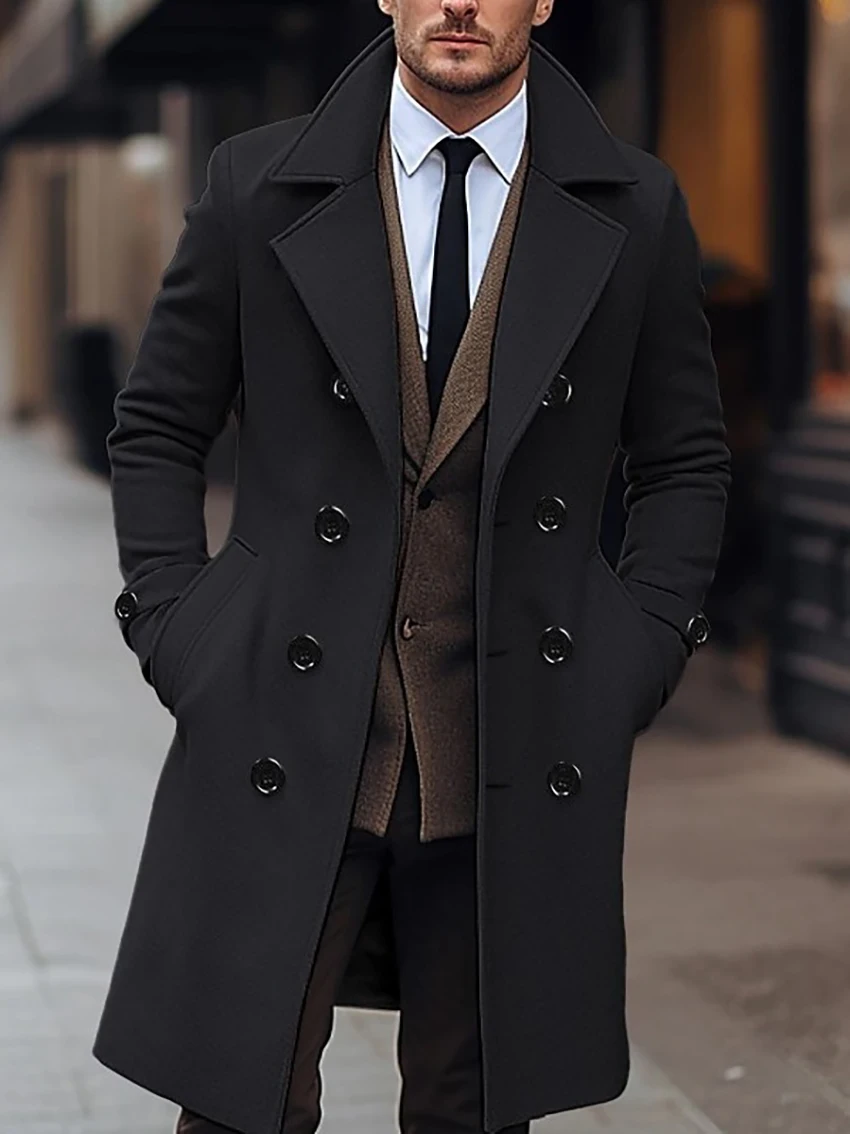
Smart-Casual Styling for Versatility
While the double-breasted coat has deep roots in formal traditions, it also shines in smart-casual settings, where it adds structure and refinement to more relaxed pieces.
The key to successful smart-casual styling lies in balancing the coat’s inherent formality with more relaxed companion pieces. A navy double-breasted wool coat pairs beautifully with tan chinos, a light merino turtleneck, and suede chukka boots. This combination maintains the coat’s sophisticated character while creating a more approachable overall look.
Layering plays an essential role in smart-casual styling. Try these tested combinations:
– Gray double-breasted coat + burgundy cashmere sweater + white Oxford button-down + navy chinos + brown loafers
– Camel double-breasted coat + black turtleneck + gray flannel trousers + Chelsea boots
– Navy double-breasted coat + light blue chambray shirt + beige chinos + desert boots
Texture becomes increasingly important in smart-casual styling. Incorporating materials like tweed, flannel, and brushed cotton creates visual interest and softens the coat’s formality. A textured scarf or knit tie can further enhance this effect.
Footwear options expand considerably in smart-casual territory. Quality leather loafers, Chelsea boots, chukka boots, and even clean, minimal sneakers can work harmoniously with your double-breasted coat when the rest of your outfit maintains appropriate balance.
These versatile approaches to how to style a double-breasted coat demonstrate the garment’s adaptability beyond boardrooms and formal events, making it a truly versatile investment for your wardrobe.
Contemporary Casual Interpretations
Breaking from tradition, modern styling approaches have liberated the double-breasted coat from its strictly formal associations. Today’s fashion-forward men are discovering exciting ways to incorporate this classic piece into casual wardrobes.
The key to casual styling lies in creating deliberate contrast between the coat’s structured formality and relaxed casual pieces. Dark denim jeans provide an ideal foundation—their sturdy texture and casual association balance perfectly against the coat’s refinement. Pair with a simple crew-neck t-shirt or lightweight sweater for an effortless look that appears intentionally understated rather than mismatched.
For footwear, clean white sneakers create a striking modern contrast with a traditional navy or black double-breasted coat. Alternatively, leather Chelsea boots bridge the gap between casual and formal elements.
Try these contemporary casual combinations:
– Black double-breasted coat + white t-shirt + dark indigo jeans + white leather sneakers
– Navy double-breasted coat + gray sweatshirt + black jeans + Chelsea boots
– Camel double-breasted coat + navy sweater + olive chinos + desert boots
The proportions become especially important when styling casually. A slightly shorter coat length (ending at mid-thigh) often works better for casual looks than traditional longer styles. This adjustment helps prevent the coat from overpowering more relaxed pieces.
For those looking to expand their casual outerwear options, exploring quality men’s wool overcoat styles provides versatile pieces that can be dressed down while maintaining their sophisticated character.
Seasonal Adaptation: Year-Round Styling
A quality double-breasted coat can serve you well beyond the depths of winter with thoughtful seasonal adaptation strategies.
Winter Styling: Embrace the coat’s full potential in cold weather by maximizing layering. Start with a fine merino base layer, add a dress shirt and knit sweater or vest, then complete with your double-breasted coat. Heavy wool, cashmere blends, and insulated options provide maximum warmth. Winter-appropriate companions include flannel trousers, heavier denim, and weather-resistant footwear.
Fall and Spring Transitions: As temperatures moderate, lighten your layers beneath. A shirt and light cardigan or just a dress shirt might suffice. Choose double-breasted coats in medium-weight wools (12-16 ounces) that provide warmth without overheating. These transitional seasons allow for more creative color play—lighter camel, soft gray, or even subtle patterns work beautifully.
Summer Evenings: In cool summer evenings, particularly in coastal or higher-elevation areas, a lightweight double-breasted coat in tropical wool, cotton blends, or even linen can serve as an elegant layer. Pair with light chinos or linen trousers and open-neck shirts for sophisticated warm-weather style.
Material Considerations: The coat’s fabric largely determines its seasonal versatility. Pure cashmere and heavy wool styles work best in winter, while wool-silk blends and lighter constructions extend wearability into transitional seasons. Some modern performance wool blends offer remarkable temperature regulation that expands the coat’s useful season.
Understanding how to adapt your coat throughout the year aligns with principles of classic men’s overcoats for formal wear, ensuring maximum value from your investment piece regardless of season.
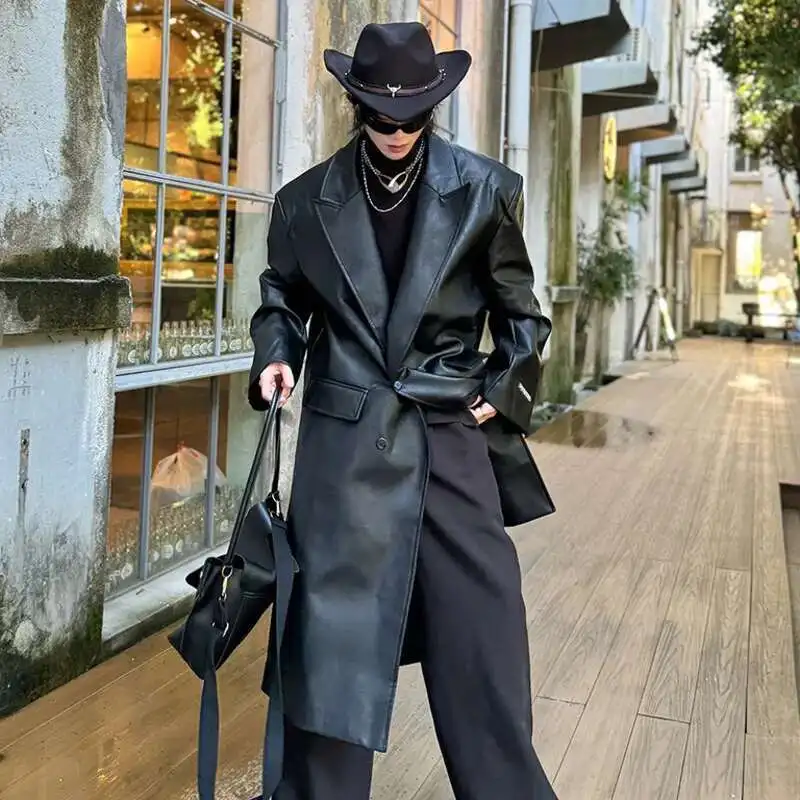
Accessorizing Your Double-Breasted Coat
The right accessories not only complete your double-breasted coat ensemble but can transform its character from strictly business to creative expression.
Scarf Styling: The double-breasted coat’s overlapping front presents unique opportunities for scarf placement. Try the “once around” technique, where a medium-weight wool scarf circles your neck once, with both ends draped inside the coat. Alternatively, for maximum warmth, the “overhand knot” tucks neatly within the coat’s closure. Choose scarves in complementary or contrasting colors—burgundy, forest green, or camel scarves pair beautifully with navy coats, while gray, navy, or black work well with camel coats.
Gloves: Quality leather gloves in colors that complement your footwear maintain visual cohesion. Brown leather gloves with brown shoes, black with black. For more casual styling, knit gloves in coordinating colors add texture and warmth.
Headwear: Classic wool felt hats like fedoras or trilbies complement the coat’s refined character. For more casual looks, a quality wool beanie in a complementary color adds warmth without undermining style.
Bags and Briefcases: Leather portfolios, briefcases, or minimalist messenger bags in colors that coordinate with your shoes and gloves create a thoughtfully composed look.
The accessories you choose can significantly influence whether your men’s wool coat presents as traditional, contemporary, or creative. By thoughtfully selecting these companion pieces, you transform a simple outfit into a complete style statement.
Mens Double Breasted Pea Coat, Mens Wool Blend Coat, Mens Wool Pea Coat
Price range: $136.84 through $157.36 Select options This product has multiple variants. The options may be chosen on the product pageMens Cashmere Overcoat, Mens Hooded Winter Coat, Mens Wool Blend Coat
Price range: $128.72 through $139.68 Select options This product has multiple variants. The options may be chosen on the product pageMens Black Overcoat, Mens Black Wool Coat, Mens Wool Overcoat
$339.18 Select options This product has multiple variants. The options may be chosen on the product pageMens Grey Overcoat, Mens Wool Blend Coat, Mens Wool Overcoat
$201.28 Select options This product has multiple variants. The options may be chosen on the product pageMens Herringbone Coat, Mens Long Overcoat, Mens Wool Overcoat
Price range: $197.16 through $203.69 Select options This product has multiple variants. The options may be chosen on the product pageMens Long Overcoat, Mens Topcoats
Price range: $189.40 through $196.88 Select options This product has multiple variants. The options may be chosen on the product page
Color Theory: Beyond Navy and Black
While navy and black double-breasted coats remain classic choices for their versatility and timeless appeal, exploring a broader color palette can distinguish your style and expand your outfit possibilities.
Neutral Expansion: Camel, light gray, and charcoal offer sophisticated alternatives that maintain versatility. A camel coat creates a softer impression than navy or black while pairing beautifully with blues, greens, and burgundies. Light gray presents a fresh, contemporary look that complements nearly any color palette, while charcoal provides the versatility of black with subtle dimension.
Color Coordination Principles: When working with colored coats, follow these guidelines:
– Create contrast between your coat and inner layers (dark coat with lighter shirt/sweater or vice versa)
– Use complementary colors (opposite on the color wheel) for dynamic combinations
– Consider monochromatic styling (variations of a single color) for sophisticated simplicity
Bold Color Options: For the confident dresser, burgundy, bottle green, or even rich brown double-breasted coats make powerful statements. These colors require more thoughtful pairing—burgundy harmonizes with navy, gray, and beige; green works with browns, creams, and grays; rich brown pairs with blues, greens, and burgundies.
Pattern Possibilities: While solid colors offer maximum versatility, patterned double-breasted coats in herringbone, subtle checks, or Prince of Wales plaid add visual interest. When styling patterned coats, keep inner layers simple and solid to avoid competing visual elements.
Understanding color theory helps you make informed choices when comparing double-breasted vs. single-breasted options, as the double-breasted style’s bolder presence often benefits from thoughtful color consideration.
Contemporary Styling Trends and Inspiration
Today’s fashion landscape has revitalized the double-breasted coat, reinterpreting this classic through modern lens while preserving its essential character.
Current runway trends showcase several notable directions for double-breasted styling:
Relaxed Proportions: Contemporary designers are offering slightly oversized double-breasted silhouettes that create a more relaxed appearance while maintaining structure through the shoulders. These modern interpretations pair beautifully with casual pieces for an elegant yet approachable look.
Creative Textures: Beyond traditional smooth wools, today’s double-breasted coats explore bouclé textures, brushed finishes, and subtle patterns that add visual and tactile interest. These textures create depth even in classic colors like navy and black.
Unstructured Options: While traditional double-breasted coats feature structured shoulders and canvassing, some modern interpretations offer softer construction that drapes more naturally. These unstructured versions pair particularly well with casual outfits.
Belt Adaptations: Some contemporary designs incorporate belts or half-belts that add definition to the waist while referencing military heritage. This detail adds visual interest while enhancing the coat’s flattering silhouette.
Street style continues to showcase double-breasted coats paired with unexpected elements like graphic t-shirts, technical fabrics, and designer sneakers—proving that traditional pieces can feel thoroughly modern with thoughtful styling.
For those looking to stay current while investing in classic pieces, the definitive guide to double-breasted overcoat styles offers insights into designs that balance timeless appeal with contemporary relevance.
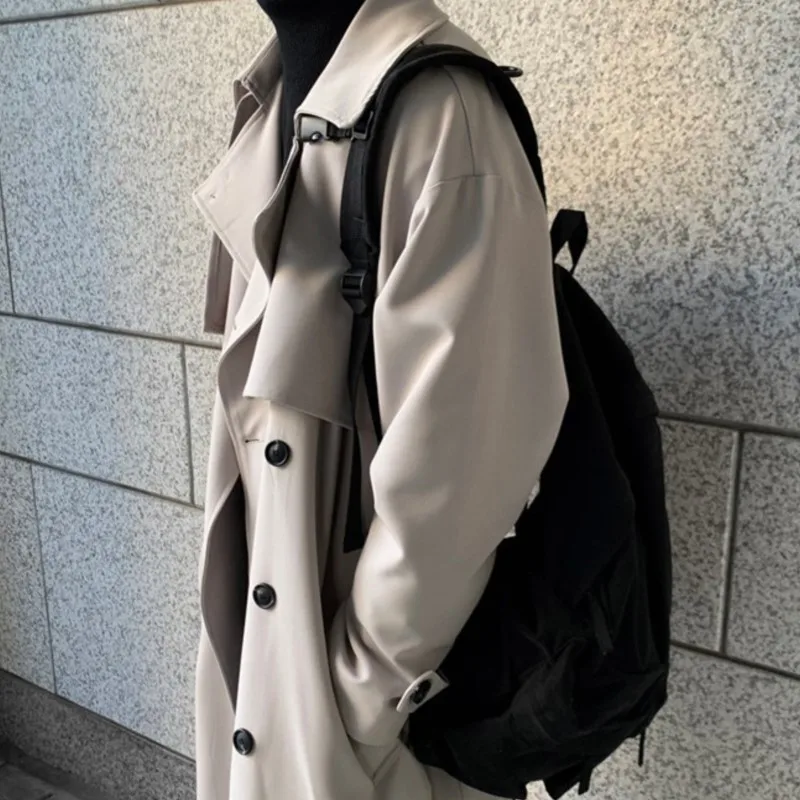
Breaking the Rules: Advanced Styling Techniques
Once you’ve mastered the fundamentals of double-breasted coat styling, experimenting with rule-breaking approaches can lead to distinctive personal expressions that set your look apart.
Proportion Play: Traditional wisdom suggests maintaining balanced proportions, but intentional contrast can create striking visual interest. Try pairing an oversized double-breasted coat with slim trousers and chunky footwear, creating a deliberate tension between volumes. Alternatively, a perfectly fitted coat can complement relaxed-fit pants for a modern silhouette.
Unexpected Layering: Challenge conventional layering by placing unconventional pieces beneath your coat. A hoodie under a tailored double-breasted coat creates intriguing textural and formal contrast. Similarly, a turtleneck sweater layered over a button-down shirt with the collar exposed adds visual complexity.
Creative Closure: While traditional styling dictates buttoning the coat properly, leaving it entirely unbuttoned creates a dramatic flowing silhouette that showcases your inner layers. For a middle ground, try fastening only the middle or bottom button rather than the traditional anchor button.
Gender-Fluid Approaches: Double-breasted coats have traditionally maintained distinct masculine styling, but contemporary approaches often blur these boundaries. Pairing your coat with fluid silhouettes or traditionally feminine accessories creates progressive, personalized interpretations.
These advanced techniques require confidence and a developed personal style but can transform even the most traditional double-breasted coat into a vehicle for creative expression. Looking at other classic styles like the definitive guide to classic navy pea coat can provide additional inspiration for creative reinterpretation.
Care and Maintenance for Longevity
A quality double-breasted coat represents a significant investment that can last decades with proper care. Implementing these maintenance practices will ensure your coat remains in excellent condition season after season.
Proper Storage: Always hang your coat on a broad, sturdy wooden hanger that supports the shoulders properly. Allow adequate breathing room in your closet to prevent crushing and misshaping. Before extended storage during warmer months, have the coat professionally cleaned, then store in a breathable garment bag—never plastic—to protect from dust while allowing air circulation.
Regular Maintenance: Brush your wool coat regularly with a soft clothes brush, moving in one direction to remove surface dust and debris. Address spots and spills immediately with a damp cloth, blotting rather than rubbing. For minor refreshing between cleanings, hang the coat in a steamy bathroom to release wrinkles and odors.
Professional Cleaning: Limit dry cleaning to 1-2 times per season, as excessive chemical cleaning can degrade natural fibers. Choose a reputable cleaner experienced with fine outerwear who understands proper pressing techniques that preserve the coat’s structure.
Button Care: Check and tighten buttons regularly, as they often loosen with wear. Keep matching spare buttons (usually provided with quality coats) for emergency replacements. Understanding proper double-breasted coat buttoning techniques prevents unnecessary strain on buttons and fabric.
With appropriate care, your double-breasted coat will develop a beautiful patina over time while maintaining its distinguished appearance and structural integrity.
Common Styling Mistakes to Avoid
Even the finest double-breasted coat can be undermined by these common styling missteps:
Improper Fit: Either too tight (causing the front to pull open) or too loose (creating a sloppy, overwhelming appearance). The coat should close comfortably while maintaining clean lines.
Incorrect Button Fastening: Many men mistakenly button all available buttons. Traditionally, on a 6×2 coat, only the middle button or middle two buttons should be fastened. The bottom button always remains unfastened.
Mismatched Formality: Pairing highly formal elements (like tuxedo trousers) with casual pieces (like sneakers) creates visual discord unless done very intentionally. Maintain relative consistency in formality across your outfit.
Competitive Patterns: Wearing bold patterns both in your coat and inner layers creates visual chaos. If your coat features a strong pattern, keep inner layers solid or subtly textured.
Neglecting Proportions: Very tall men should avoid very short coats, while shorter men benefit from coats that end above the knee to create favorable proportions.
Sleeve Length Errors: Sleeves that completely cover shirt cuffs or expose excessive cuff length disrupt the coat’s refined appearance.
Collar Gap: When a coat’s collar stands away from your neck rather than lying flat, it indicates a poor fit that requires tailoring.
Understanding the definitive guide to wearing a double-breasted coat helps you avoid these pitfalls while maximizing your coat’s potential.
Is the Double-Breasted Coat Right for You?
While undeniably classic, the double-breasted coat isn’t automatically right for everyone. Consider these factors when determining if this style aligns with your needs:
Body Type Considerations: Double-breasted coats typically flatter men with broader shoulders and average to tall heights, as the coat’s structure enhances these proportions. If you have a very slim build, look for more fitted contemporary cuts that won’t overwhelm your frame. For broader builds, ensure the coat provides enough room across the chest and shoulders while maintaining definition at the waist.
Personal Style Alignment: Consider your existing wardrobe and style preferences. If you primarily dress in casual clothing like jeans and t-shirts, a double-breasted coat might feel incongruous unless you’re specifically seeking to elevate your look. However, if your wardrobe includes tailored pieces, dress shirts, and quality footwear, a double-breasted coat will integrate seamlessly.
Lifestyle Factors: Your daily activities and environments influence whether this coat will serve you well. Professional settings, formal occasions, and urban environments align naturally with the double-breasted style. More casual workplaces or rural settings might be better suited to single-breasted or more casual coat styles.
Confidence Factor: The double-breasted coat makes a stronger statement than its single-breasted counterpart. If you’re comfortable drawing attention and projecting confidence, this style will complement your personal presence.
For those still considering various options, Metro Cloak’s collection of men’s overcoats offers diverse styles to match different preferences and needs.
From Formal to Casual: Your Complete Double-Breasted Lookbook
Having explored the versatility of the double-breasted coat across various contexts, these essential outfit formulas provide a practical reference for styling this classic garment:
Business Formal: Navy double-breasted wool coat + charcoal suit + white shirt + burgundy tie + black Oxford shoes
Creative Professional: Camel double-breasted coat + navy blazer + light blue shirt + gray flannel trousers + brown brogues
Smart Evening: Black double-breasted coat + black turtleneck + charcoal trousers + black Chelsea boots
Weekend Refined: Gray double-breasted coat + navy crew neck sweater + white Oxford shirt + dark jeans + suede chukka boots
Modern Casual: Navy double-breasted coat + gray sweatshirt + black jeans + white sneakers
The double-breasted coat’s enduring appeal lies in this remarkable versatility—its ability to elevate any outfit while maintaining its distinguished character. Whether you’re dressing for the boardroom, a formal event, or a casual weekend, the right styling approach transforms this classic piece into a personal statement.
By mastering these combinations and understanding the principles behind them, you’re equipped to incorporate the double-breasted coat into your personal style with confidence and sophistication. The ultimate guide to styling long overcoats provides additional inspiration for incorporating this timeless piece into your wardrobe.

